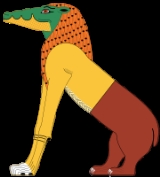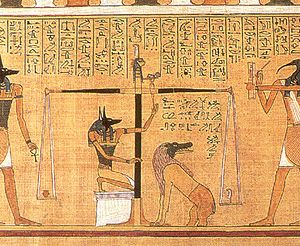
Ammit
Encyclopedia

Demon
call - 1347 531 7769 for more infoIn Ancient Near Eastern religions as well as in the Abrahamic traditions, including ancient and medieval Christian demonology, a demon is considered an "unclean spirit" which may cause demonic possession, to be addressed with an act of exorcism...
with a body that was part lion
Lion
The lion is one of the four big cats in the genus Panthera, and a member of the family Felidae. With some males exceeding 250 kg in weight, it is the second-largest living cat after the tiger...
, hippopotamus
Hippopotamus
The hippopotamus , or hippo, from the ancient Greek for "river horse" , is a large, mostly herbivorous mammal in sub-Saharan Africa, and one of only two extant species in the family Hippopotamidae After the elephant and rhinoceros, the hippopotamus is the third largest land mammal and the heaviest...
and crocodile
Crocodile
A crocodile is any species belonging to the family Crocodylidae . The term can also be used more loosely to include all extant members of the order Crocodilia: i.e...
— the three largest "man-eating" animals known to ancient Egyptians. A funerary deity, her titles included "Devourer of the Dead", "Eater of Heart
Heart
The heart is a myogenic muscular organ found in all animals with a circulatory system , that is responsible for pumping blood throughout the blood vessels by repeated, rhythmic contractions...
s", and "Great of Death".
Ammit lived near the scales of justice
Scales of Justice
Scales of Justice can refer to:* Justice* Scales held by Lady Justice symbolizing the measure of a case's support and opposition* Scales of Justice , a 1983 Australian television drama* Scales of Justice , a 1990 American series...
in Duat
Duat
In Egyptian mythology, Duat is the underworld. The Duat is a vast area under the Earth, connected with Nun, the waters of the primordial abyss. The Duat is the realm of the god Osiris and the residence of other gods and supernatural beings...
, the Egyptian underworld
Underworld
The Underworld is a region which is thought to be under the surface of the earth in some religions and in mythologies. It could be a place where the souls of the recently departed go, and in some traditions it is identified with Hell or the realm of death...
. In the Hall of Two Truths, Anubis
Anubis
Anubis is the Greek name for a jackal-headed god associated with mummification and the afterlife in ancient Egyptian religion. In the ancient Egyptian language, Anubis is known as Inpu . According to the Akkadian transcription in the Amarna letters, Anubis' name was vocalized as Anapa...
weighed the heart of a person against Ma'at, the goddess
Goddess
A goddess is a female deity. In some cultures goddesses are associated with Earth, motherhood, love, and the household. In other cultures, goddesses also rule over war, death, and destruction as well as healing....
of truth, who was sometimes depicted symbolically as an ostrich feather. If the heart was judged to be not pure, Ammit would devour it, and the person undergoing judgement was not allowed to continue their voyage towards Osiris
Osiris
Osiris is an Egyptian god, usually identified as the god of the afterlife, the underworld and the dead. He is classically depicted as a green-skinned man with a pharaoh's beard, partially mummy-wrapped at the legs, wearing a distinctive crown with two large ostrich feathers at either side, and...
and immortality
Immortality
Immortality is the ability to live forever. It is unknown whether human physical immortality is an achievable condition. Biological forms have inherent limitations which may or may not be able to be overcome through medical interventions or engineering...
. Once Ammut swallowed the heart, the soul was believed to become restless forever; this was called "to die a second time". Ammit was also sometimes said to stand by a lake of fire
Lake of Fire
A lake of fire appears, in both ancient Egyptian and Christian religion, as a place of after-death punishment of the wicked. The phrase is used in four verses of the Book of Revelation. The image was also used by the Early Christian Hippolytus of Rome in about the year 200 and has continued to be...
. In some traditions, the unworthy hearts were cast into the fiery lake to be destroyed. Some scholars believe Ammit and the lake represent the same concept of destruction.
Ammit was not worshipped, and was never regarded as a goddess
Goddess
A goddess is a female deity. In some cultures goddesses are associated with Earth, motherhood, love, and the household. In other cultures, goddesses also rule over war, death, and destruction as well as healing....
; instead she embodied all that the Egyptians
Egyptians
Egyptians are nation an ethnic group made up of Mediterranean North Africans, the indigenous people of Egypt.Egyptian identity is closely tied to geography. The population of Egypt is concentrated in the lower Nile Valley, the small strip of cultivable land stretching from the First Cataract to...
feared, threatening to bind them to eternal restlessness if they did not follow the principle of Ma'at.
Ammit has been linked with the goddess Tawaret
Tawaret
In Egyptian mythology, Taweret is the Egyptian Goddess of childbirth and fertility. The name "Taweret" means, "she who is great" or simply, "great one"...
, who has a similar physical appearance and, as a companion of Bes
Bes
Bes was an Egyptian deity worshipped in the later periods of dynastic history as a protector of households and in particular mothers and children. In time he would be regarded as the defender of everything good and the enemy of all that is bad...
, also protected others from evil. Other authors have noted that Ammit's lion characteristics, and the lake of fire
Lake of Fire
A lake of fire appears, in both ancient Egyptian and Christian religion, as a place of after-death punishment of the wicked. The phrase is used in four verses of the Book of Revelation. The image was also used by the Early Christian Hippolytus of Rome in about the year 200 and has continued to be...
, may be pointers to a connection with the goddess Sekhmet
Sekhmet
In Egyptian mythology, Sekhmet , was originally the warrior goddess as well as goddess of healing for Upper Egypt. She is depicted as a lioness, the fiercest hunter known to the Egyptians. It was said that her breath created the desert...
. The relation to afterlife punishment and lake of fire location are also shared with the baboon diety Babi
Babi (mythology)
In Egyptian mythology, Babi, also Baba, was the deification of the baboon, one of the animals present in Egypt. His name is usually translated as Bull of the baboons, and roughly means Alpha male of all baboons, i.e. chief of the baboons...
.
See also
- Ancient Egyptian religion
- Book of the DeadBook of the DeadThe Book of the Dead is the modern name of an ancient Egyptian funerary text, used from the beginning of the New Kingdom to around 50 BC. The original Egyptian name for the text, transliterated rw nw prt m hrw is translated as "Book of Coming Forth by Day". Another translation would be "Book of...
- Ma'at
- Sekhemet
- BabiBabi (mythology)In Egyptian mythology, Babi, also Baba, was the deification of the baboon, one of the animals present in Egypt. His name is usually translated as Bull of the baboons, and roughly means Alpha male of all baboons, i.e. chief of the baboons...
- Lake of fireLake of FireA lake of fire appears, in both ancient Egyptian and Christian religion, as a place of after-death punishment of the wicked. The phrase is used in four verses of the Book of Revelation. The image was also used by the Early Christian Hippolytus of Rome in about the year 200 and has continued to be...
- AnubisAnubisAnubis is the Greek name for a jackal-headed god associated with mummification and the afterlife in ancient Egyptian religion. In the ancient Egyptian language, Anubis is known as Inpu . According to the Akkadian transcription in the Amarna letters, Anubis' name was vocalized as Anapa...
- TawaretTawaretIn Egyptian mythology, Taweret is the Egyptian Goddess of childbirth and fertility. The name "Taweret" means, "she who is great" or simply, "great one"...
- Scales of justiceScales of JusticeScales of Justice can refer to:* Justice* Scales held by Lady Justice symbolizing the measure of a case's support and opposition* Scales of Justice , a 1983 Australian television drama* Scales of Justice , a 1990 American series...
- DuatDuatIn Egyptian mythology, Duat is the underworld. The Duat is a vast area under the Earth, connected with Nun, the waters of the primordial abyss. The Duat is the realm of the god Osiris and the residence of other gods and supernatural beings...

